英语语法大攻克--过去将来时
- 格式:doc
- 大小:25.00 KB
- 文档页数:3
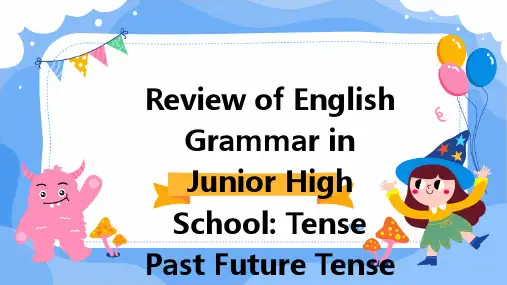
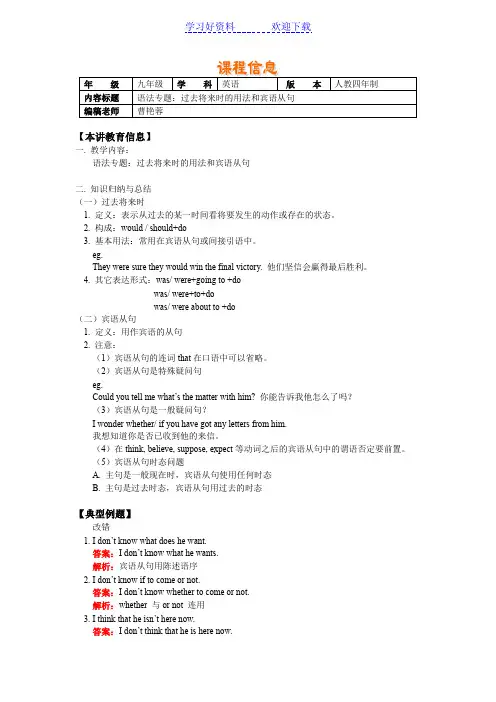
【本讲教育信息】一. 教学内容:语法专题:过去将来时的用法和宾语从句二. 知识归纳与总结(一)过去将来时1. 定义:表示从过去的某一时间看将要发生的动作或存在的状态。
2. 构成:would / should+do3. 基本用法:常用在宾语从句或间接引语中。
eg.They were sure they would win the final victory. 他们坚信会赢得最后胜利。
4. 其它表达形式:was/ were+going to +dowas/ were+to+dowas/ were about to +do(二)宾语从句1. 定义:用作宾语的从句2. 注意:(1)宾语从句的连词that在口语中可以省略。
(2)宾语从句是特殊疑问句eg.Could you tell me what’s the matter with him? 你能告诉我他怎么了吗?(3)宾语从句是一般疑问句?I wonder whether/ if you have got any letters from him.我想知道你是否已收到他的来信。
(4)在think, believe, suppose, expect等动词之后的宾语从句中的谓语否定要前置。
(5)宾语从句时态问题A. 主句是一般现在时,宾语从句使用任何时态B. 主句是过去时态,宾语从句用过去的时态【典型例题】改错1. I don’t know what does he want.答案:I don’t know what he wants.解析:宾语从句用陈述语序2. I don’t know if to come or not.答案:I don’t know whether to come or not.解析:whether 与or not 连用3. I think that he isn’t here now.答案:I don’t think that he is here now.解析:think后面的宾语从句的否定前置4. I don’t know that how he did it.答案:I don’t know how he did it.解析:how 就是连接词,故that删去。
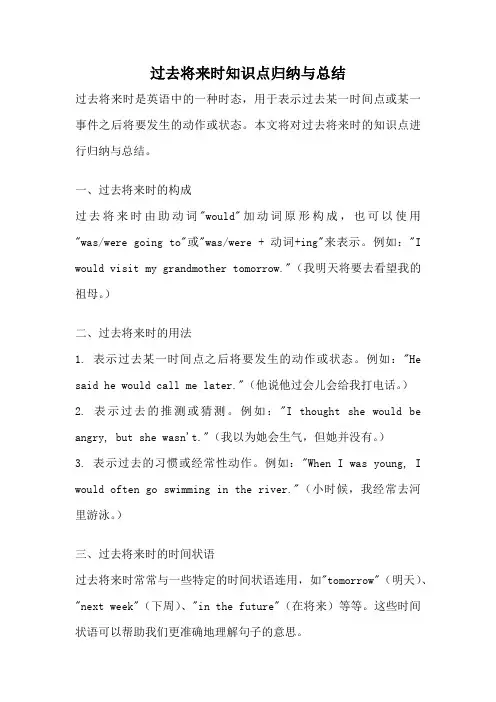
过去将来时知识点归纳与总结过去将来时是英语中的一种时态,用于表示过去某一时间点或某一事件之后将要发生的动作或状态。
本文将对过去将来时的知识点进行归纳与总结。
一、过去将来时的构成过去将来时由助动词"would"加动词原形构成,也可以使用"was/were going to"或"was/were + 动词+ing"来表示。
例如:"I would visit my grandmother tomorrow."(我明天将要去看望我的祖母。
)二、过去将来时的用法1. 表示过去某一时间点之后将要发生的动作或状态。
例如:"He said he would call me later."(他说他过会儿会给我打电话。
)2. 表示过去的推测或猜测。
例如:"I thought she would be angry, but she wasn't."(我以为她会生气,但她并没有。
)3. 表示过去的习惯或经常性动作。
例如:"When I was young, I would often go swimming in the river."(小时候,我经常去河里游泳。
)三、过去将来时的时间状语过去将来时常常与一些特定的时间状语连用,如"tomorrow"(明天)、"next week"(下周)、"in the future"(在将来)等等。
这些时间状语可以帮助我们更准确地理解句子的意思。
四、过去将来时与其他时态的区别过去将来时与其他时态的区别主要在于时间上的不同。
过去将来时表示过去某一时间点之后将要发生的动作或状态,而其他时态则表示不同的时间关系。
例如,现在完成时表示过去发生的某个动作对现在产生的影响,而将来进行时表示将来某一时间点正在进行的动作。
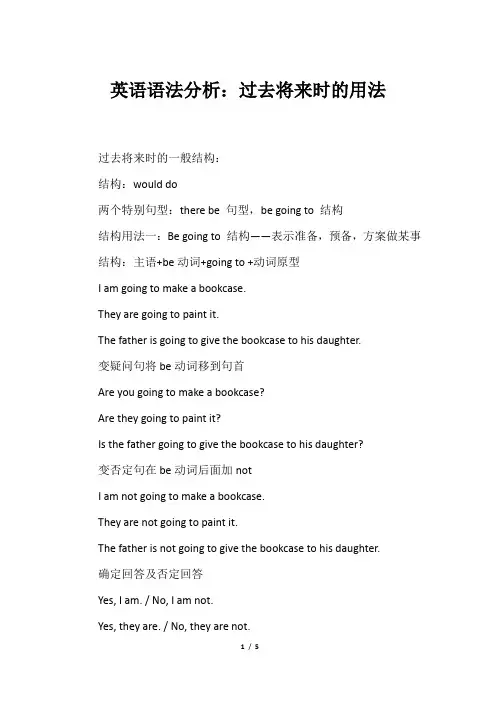
英语语法分析:过去将来时的用法过去将来时的一般结构:结构:would do两个特别句型:there be 句型,be going to 结构结构用法一:Be going to 结构——表示准备,预备,方案做某事结构:主语+be动词+going to +动词原型I am going to make a bookcase.They are going to paint it.The father is going to give the bookcase to his daughter.变疑问句将be动词移到句首Are you going to make a bookcase?Are they going to paint it?Is the father going to give the bookcase to his daughter?变否定句在be动词后面加notI am not going to make a bookcase.They are not going to paint it.The father is not going to give the bookcase to his daughter.确定回答及否定回答Yes, I am. / No, I am not.Yes, they are. / No, they are not.Yes, he is. / No, he is not.特别疑问句(必背)What are you going to do?What are they going to do?What is the father going to do?结构用法二:There be 句型——表示哪里有什么东西(某处有某物)There is+单数名词+表示场所的词(一般为介词词组)There is a book in this room.There is a pen on the tableThere are+复数名词+表示场所的词(一般为介词词组)There are two pens on the table.There are three schools there.变疑问句将be动词移到句首Is there a book in this room?Are there two pens on the table?变否定句在动词后面加notThere is not a book in this room.There are not two pens on the table.确定回答及否定回答Yes, there is. / No, there is not.Yes, there are. / No, there are not.过去将来时的用法一、"would+动词原形"表示过去将来时"would+动词原形"构成过去将来时,常表示依据方案或支配即将发生的事。
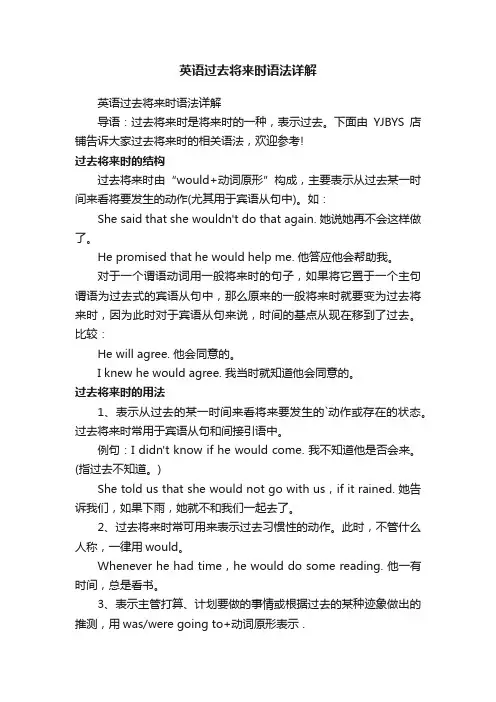
英语过去将来时语法详解英语过去将来时语法详解导语:过去将来时是将来时的一种,表示过去。
下面由YJBYS店铺告诉大家过去将来时的相关语法,欢迎参考!过去将来时的结构过去将来时由“would+动词原形”构成,主要表示从过去某一时间来看将要发生的动作(尤其用于宾语从句中)。
如:She said that she wouldn't do that again. 她说她再不会这样做了。
He promised that he would help me. 他答应他会帮助我。
对于一个谓语动词用一般将来时的句子,如果将它置于一个主句谓语为过去式的宾语从句中,那么原来的一般将来时就要变为过去将来时,因为此时对于宾语从句来说,时间的基点从现在移到了过去。
比较:He will agree. 他会同意的。
I knew he would agree. 我当时就知道他会同意的。
过去将来时的用法1、表示从过去的某一时间来看将来要发生的`动作或存在的状态。
过去将来时常用于宾语从句和间接引语中。
例句:I didn't know if he would come. 我不知道他是否会来。
(指过去不知道。
)She told us that she would not go with us,if it rained. 她告诉我们,如果下雨,她就不和我们一起去了。
2、过去将来时常可用来表示过去习惯性的动作。
此时,不管什么人称,一律用would。
Whenever he had time,he would do some reading. 他一有时间,总是看书。
3、表示主管打算、计划要做的事情或根据过去的某种迹象做出的推测,用was/were going to+动词原形表示 .例句:Last Sunday we were going to visit the Great Wall, but it rained. 上星期天我们本想去游览长城的,但却下雨了。
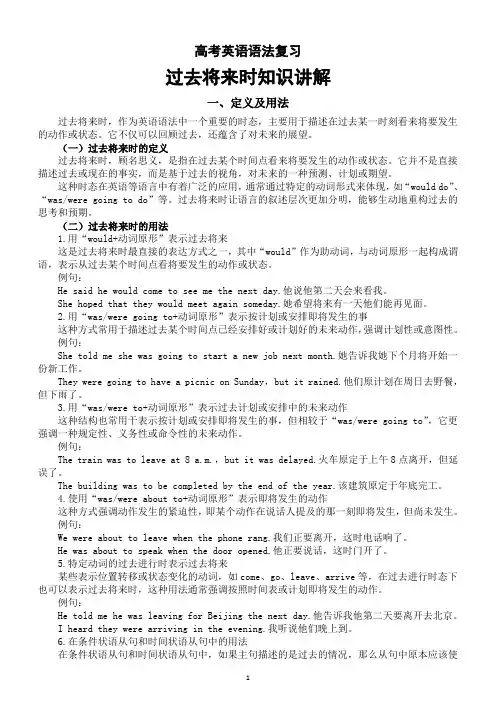
高考英语语法复习过去将来时知识讲解一、定义及用法过去将来时,作为英语语法中一个重要的时态,主要用于描述在过去某一时刻看来将要发生的动作或状态。
它不仅可以回顾过去,还蕴含了对未来的展望。
(一)过去将来时的定义过去将来时,顾名思义,是指在过去某个时间点看来将要发生的动作或状态。
它并不是直接描述过去或现在的事实,而是基于过去的视角,对未来的一种预测、计划或期望。
这种时态在英语等语言中有着广泛的应用,通常通过特定的动词形式来体现,如“would do”、“was/were going to do”等。
过去将来时让语言的叙述层次更加分明,能够生动地重构过去的思考和预期。
(二)过去将来时的用法1.用“would+动词原形”表示过去将来这是过去将来时最直接的表达方式之一,其中“would”作为助动词,与动词原形一起构成谓语,表示从过去某个时间点看将要发生的动作或状态。
例句:He said he would come to see me the next day.他说他第二天会来看我。
She hoped that they would meet again someday.她希望将来有一天他们能再见面。
2.用“was/were going to+动词原形”表示按计划或安排即将发生的事这种方式常用于描述过去某个时间点已经安排好或计划好的未来动作,强调计划性或意图性。
例句:She told me she was going to start a new job next month.她告诉我她下个月将开始一份新工作。
They were going to have a picnic on Sunday,but it rained.他们原计划在周日去野餐,但下雨了。
3.用“was/were to+动词原形”表示过去计划或安排中的未来动作这种结构也常用于表示按计划或安排即将发生的事,但相较于“was/were going to”,它更强调一种规定性、义务性或命令性的未来动作。
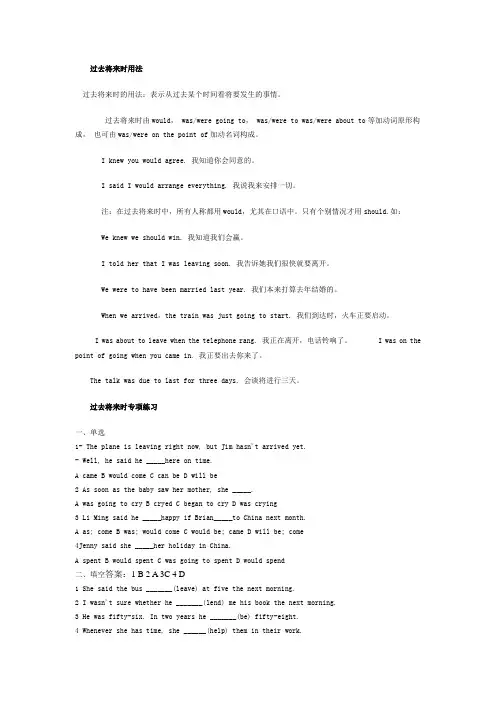
过去将来时用法过去将来时的用法:表示从过去某个时间看将要发生的事情。
过去将来时由would, was/were going to, was/were to was/were about to等加动词原形构成,也可由was/were on the point of加动名词构成。
I knew you would agree. 我知道你会同意的。
I said I would arrange everything. 我说我来安排一切。
注:在过去将来时中,所有人称都用would,尤其在口语中。
只有个别情况才用should.如:We knew we should win. 我知道我们会赢。
I told her that I was leaving soon. 我告诉她我们很快就要离开。
We were to have been married last year. 我们本来打算去年结婚的。
When we arrived,the train was just going to start. 我们到达时,火车正要启动。
I was about to leave when the telephone rang. 我正在离开,电话铃响了。
I was on the point of going when you came in. 我正要出去你来了。
The talk was due to last for three days. 会谈将进行三天。
过去将来时专项练习一、单选1- The plane is leaving right now, but Jim hasn't arrived yet.- Well, he said he _____here on time.A cameB would comeC can beD will be2 As soon as the baby saw her mother, she _____.A was going to cryB cryedC began to cryD was crying3 Li Ming said he _____happy if Brian_____to China next month.A as; comeB was; would comeC would be; cameD will be; come4Jenny said she _____her holiday in China.A spentB would spentC was going to spentD would spend二、填空答案:1 B 2 A 3C 4 D1 She said the bus _______(leave) at five the next morning.2 I wasn't sure whether he _______(lend) me his book the next morning.3 He was fifty-six. In two years he _______(be) fifty-eight.4 Whenever she has time, she ______(help) them in their work.1 was leaving2 would lend3 would be4 would help。
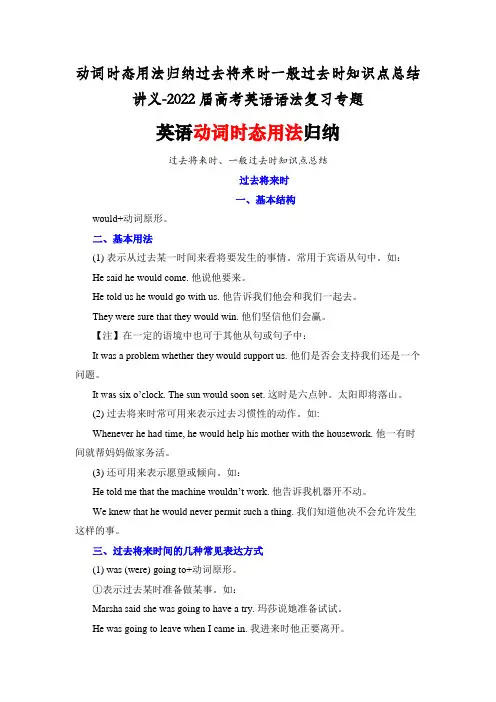
动词时态用法归纳过去将来时一般过去时知识点总结讲义-2022届高考英语语法复习专题英语动词时态用法归纳过去将来时、一般过去时知识点总结过去将来时一、基本结构would+动词原形。
二、基本用法(1) 表示从过去某一时间来看将要发生的事情。
常用于宾语从句中。
如:He said he would come. 他说他要来。
He told us he would go with us. 他告诉我们他会和我们一起去。
They were sure that they would win. 他们坚信他们会赢。
【注】在一定的语境中也可于其他从句或句子中:It was a problem whether they would support us. 他们是否会支持我们还是一个问题。
It was six o’clock. The sun would soon set.这时是六点钟。
太阳即将落山。
(2) 过去将来时常可用来表示过去习惯性的动作。
如:Whenever he had time, he would help his mother with the housework. 他一有时间就帮妈妈做家务活。
(3) 还可用来表示愿望或倾向。
如:He told me that the machine wouldn’t work.他告诉我机器开不动。
We knew that he would never permit such a thing. 我们知道他决不会允许发生这样的事。
三、过去将来时间的几种常见表达方式(1) was (were) going to+动词原形。
①表示过去某时准备做某事。
如:Marsha said she was going to have a try. 玛莎说她准备试试。
He was going to leave when I came in. 我进来时他正要离开。
②was going to有时可表示过去未曾实现的想法或打算。
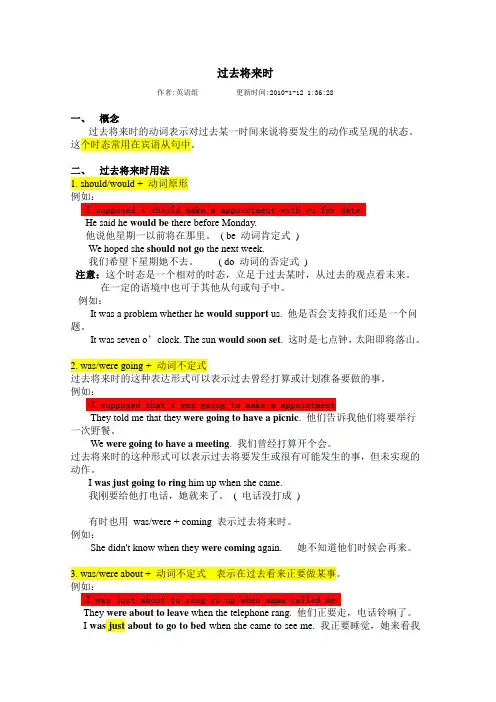
过去将来时作者:英语组更新时间:2010-1-12 1:36:28一、概念过去将来时的动词表示对过去某一时间来说将要发生的动作或呈现的状态。
这个时态常用在宾语从句中。
二、过去将来时用法1. should/would + 动词原形例如:I supposed i should make a appointment with yu for date.He said he would be there before Monday.他说他星期一以前将在那里。
( be 动词肯定式)We hoped she should not go the next week.我们希望下星期她不去。
( do 动词的否定式)注意:这个时态是一个相对的时态,立足于过去某时,从过去的观点看未来。
在一定的语境中也可于其他从句或句子中。
例如:It was a problem whether he would support us. 他是否会支持我们还是一个问题。
It was seven o’clock. The sun would soon set. 这时是七点钟,太阳即将落山。
2. was/were going + 动词不定式过去将来时的这种表达形式可以表示过去曾经打算或计划准备要做的事。
例如:I supposed that i was going to make a appointmentThey told me that they were going to have a picnic. 他们告诉我他们将要举行一次野餐。
We were going to have a meeting. 我们曾经打算开个会。
过去将来时的这种形式可以表示过去将要发生或很有可能发生的事,但未实现的动作。
I was just going to ring him up when she came.我刚要给他打电话,她就来了。
( 电话没打成)有时也用was/were + coming 表示过去将来时。
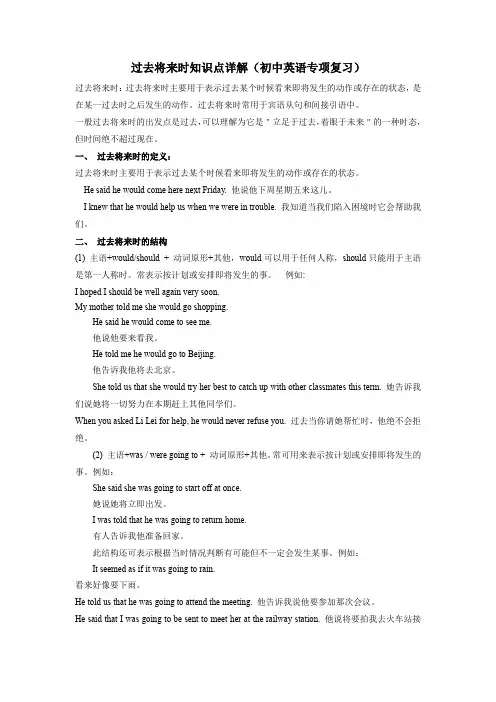
过去将来时知识点详解(初中英语专项复习)过去将来时:过去将来时主要用于表示过去某个时候看来即将发生的动作或存在的状态,是在某一过去时之后发生的动作。
过去将来时常用于宾语从句和间接引语中。
一般过去将来时的出发点是过去,可以理解为它是"立足于过去,着眼于未来"的一种时态,但时间绝不超过现在。
一、过去将来时的定义:过去将来时主要用于表示过去某个时候看来即将发生的动作或存在的状态。
He said he would come here next Friday. 他说他下周星期五来这儿。
I knew that he would help us when we were in trouble. 我知道当我们陷入困境时它会帮助我们。
二、过去将来时的结构(1) 主语+would/should + 动词原形+其他,would可以用于任何人称,should只能用于主语是第一人称时。
常表示按计划或安排即将发生的事。
例如:I hoped I should be well again very soon.My mother told me she would go shopping.He said he would come to see me.他说他要来看我。
He told me he would go to Beijing.他告诉我他将去北京。
She told us that she would try her best to catch up with other classmates this term. 她告诉我们说她将一切努力在本期赶上其他同学们。
When you asked Li Lei for help, he would never refuse you. 过去当你请她帮忙时,他绝不会拒绝。
(2) 主语+was / were going to + 动词原形+其他。
常可用来表示按计划或安排即将发生的事。
例如:She said she was going to start off at once.她说她将立即出发。
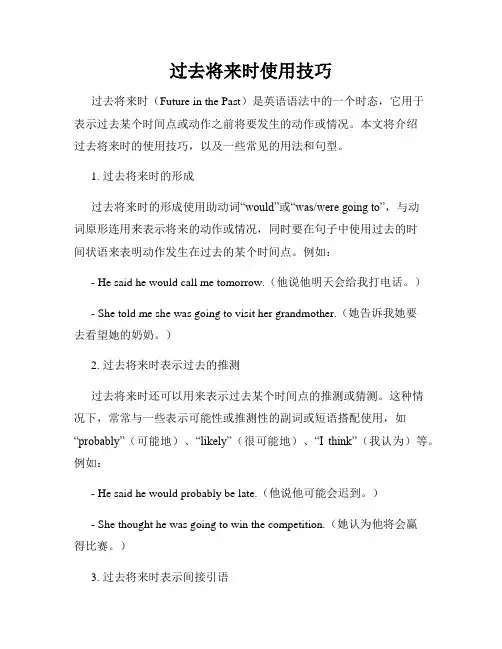
过去将来时使用技巧过去将来时(Future in the Past)是英语语法中的一个时态,它用于表示过去某个时间点或动作之前将要发生的动作或情况。
本文将介绍过去将来时的使用技巧,以及一些常见的用法和句型。
1. 过去将来时的形成过去将来时的形成使用助动词“would”或“was/were going to”,与动词原形连用来表示将来的动作或情况,同时要在句子中使用过去的时间状语来表明动作发生在过去的某个时间点。
例如:- He said he would call me tomorrow.(他说他明天会给我打电话。
)- She told me she was going to visit her grandmother.(她告诉我她要去看望她的奶奶。
)2. 过去将来时表示过去的推测过去将来时还可以用来表示过去某个时间点的推测或猜测。
这种情况下,常常与一些表示可能性或推测性的副词或短语搭配使用,如“probably”(可能地)、“likely”(很可能地)、“I think”(我认为)等。
例如:- He said he would probably be late.(他说他可能会迟到。
)- She thought he was going to win the competition.(她认为他将会赢得比赛。
)3. 过去将来时表示间接引语当我们将直接引语转换为间接引语时,如果直接引语中的动词是将来时态,那么在间接引语中就要使用过去将来时。
例如:- He said, "I will meet you tomorrow." → He said he would meet me the next day.(他说:“明天我会见你。
”→他说他第二天会见我。
)4. 过去将来时与其它过去时态的区别过去将来时与其它过去时态的区别在于它强调的是过去某个时间点之前将要发生的动作或情况。
而过去完成时则强调的是在过去某个时间点之前已经完成的动作或情况。
什么是过去将来时?初中英语必备语法知识2023年了,你是否依然对英语语法知识感到陌生?那么,让我来为你介绍初中英语必备语法知识之一——过去将来时。
首先,让我们来了解过去将来时的定义。
过去将来时指的是在过去的某个时间,表达对未来某个时间或某个事件的预计、猜测或想象。
它通常由“would”或“was/were going to”构成,即“would/was/were going to+动词原形”。
下面,让我们来看几个例句,以更深入地理解过去将来时。
1. When I was in high school, I thought I would become a doctor in the future.(我上高中的时候,我觉得将来我会成为一名医生。
)其中“thought I would become”便是过去将来时的形式。
2. John was going to propose to Mary, but then he changed his mind.(John本来打算向Mary求婚,但后来改变了主意。
)这句话中,“was going to propose”也是过去将来时的形式。
3. We knew that it would rain tomorrow.(我们知道明天会下雨。
)这个例子用的是“I knew”而不是“I was going to know”的形式,但仍然用了过去将来时的“would”。
那么,过去将来时有什么用途呢?我们可以通过它来表达在过去的某一个时间点,我们做出了对未来的预测或打算。
它也可以用于虚拟语气,在某些假设的情况下,表达出预测未来时的假设。
例如,下面是一个假设句:如果我今晚早点睡觉,我会更有精神明天起床。
如果用过去将来时来表达:If I went to bed early tonight, I would feel more refreshed when I woke up tomorrow.(如果我今晚早点睡觉,我明天起床的时候会觉得更舒服。
直接引语变间接引语(时间地点状语的转变)但要注意在以下几种情况下,在直接引语变为间接引语时,时态一般不变化。
①直接引语是客观真理或是谚语格言时,如:"The earth moves around the sun and the moon moves around the earth, the teacher told me. → The teacher told me the earth moves around the sun and the moon moves around the earth。
He said,“Practice makes perfect.” ——>He said that practice makes perfect.②直接引语是过去进行时,时态不变。
如:Jack said, "John, where were you going when I met you in the street?" →Jack asked John where he was going when he met him in the street。
③直接引语中有具体的过去某年、某月、某日作状语,变为间接引语时,时态不变。
如:Xiao Wang said. "I was born on April 2l, 1980。
" →Xiao Wang said he was born on April 20, 1980。
④直接引语如果是一般现在时,表示一种反复出现或习惯性的动作,变间接引语,时态不变。
如:He said, "I get up at six every morning。
" →He said he gets up at six every morning。
⑤如果直接引语中的情态动词没有过去时的形式(例:ought to,had better, used to)和已经是过去时的形式时,(例:could, should, would, might)不再变。
高一英语语法(2-3):动词的时态之一般将来时、过去将来时、将来完成时一、一般将来时(will work):一般将来时的5种表达方式。
1.“shall / will + V原”是将来时的最普通的表达方式,表示从现在来看以后要发生的动作或存在的状态,指事物的固有属性或必然趋势。
如:We __________ (go) to ask Miss Chen for help. (shall和will表达一般将来时有何区别?)2.“am / is / are going to + V原”多用于口语中,表示“打算或计划要做某事”。
此外,还可以表示说话人根据已有的事实或迹象,对未来进行推断。
如:They __________ (meet) outside the school gate.(打算或计划要做某事)(根据已有的迹象,对未来进行推断)3.“am / is / are about to + V原”表示“即将……”,它不与表示时间的副词或时间状语连用。
如:The English evening __________ (start).4.“am / is / are to + V原”表示“按计划、安排即将发生的动作”,还可以表示“吩咐、命令、禁止”等,与表示时间的副词或时间状语连用。
如:到10(命令)5.“am / is / are due to +V原”表示“按计划或时间表将要发生某事”。
如:The talk __________ (last) for five days. 会谈(按计划)将持续5天。
The race __________ (start) in ten minutes. (按时间表)还有10分钟比赛就该开始了。
现在进行时有时与某些表示瞬间动作的动词连用,可表示按计划、安排将要发生的动作。
常见动词有go, come, start, leave, stay, return, arrive, begin, take, meet等。
英语中考复习时态系列之(八)过去将来时
过去将来时表示从过去某时看将来要发生的动作或存在的状态.是在某一过去时之后发生的动作.我们可以理解为它是"立足于过去,着眼于未来"的一种时态.E.g. Li Ming said that you would be happy if you heard from me. 过去将来时还可表示过去习惯性的动作.E.g. Every evening Mr. Wang would go and talk with his students. 过去将来时常用在宾语从句中.主句为过去时,从句表示将要发生的事情.E.g. I didn't know if she would come. 它也常用于间接引语中.E.g. He told me that he would go on a trip to Beijing the next day.
其结构为"would/should +v". 第一人称用should,其它人称用would.E.g. I hoped I should be well again very soon. My mother told me she would go shopping. 过去将来时也可以用"was/were going to +v" 来表示.E.g. He said that he was going to have a walk with his mother. 注意:go , come, leave, start 等表示位置移动的动词,常用过去进行时表示一个当时按计划或安排近期将要发生的事情.E.g. He didn't say when he was coming.
常见错误是:
在条件状语从句和时间状语从句中忘记用一般过去时代替过去将来时.
例:He said that he was going to the Great Wall if it wouldn't rain (rain) the next Saturday.
答案:didn't rain
解析:条件状语从句和时间状语从句中一般不用过去将来时,而常用一般过去时表示在过去看来将要发生的动作.
专项练习:
一、单选
1- The plane is leaving right now, but Jim hasn't arrived yet. - Well, he said he _____here on time.
A came
B would come
C can be
D will be
2 As soon as the baby saw her mother, she _____.
A was going to cry
B cryed
C began to cry
D was crying
3 Li Ming said he _____happy if Brian_____to China next month.
A as; come
B was; would come
C would be; came
D will be; come
4Jenny said she _____her holiday in China.
A spent
B would spent
C was going to spent
D would spend
答案:1 B 2 A 3C 4 D
二、填空
1 She said the bus _______(leave) at five the next morning.
2 I wasn't sure whether he _______(lend) me his book the next morning.
3 He was fifty-six. In two years he _______(be) fifty-eight.
4 Whenever she has time, she ______(help) them in their work.
答案:
1 was leaving
2 would lend
3 would be
4 would help。